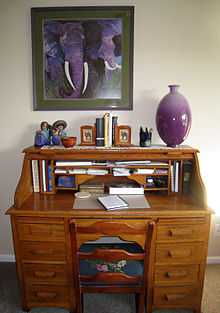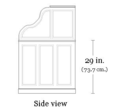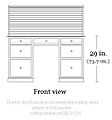Rolltop desk

A rolltop desk is a 19th-century reworking of the pedestal desk with, in addition, a series of stacked compartments, shelves, drawers and nooks in front of the user, much like the bureau à gradin or the Carlton House desk. In contrast to these the compartments and the desktop surface of a rolltop desk can be covered by means of a tambour consisting of linked wooden slats that roll or slide through slots in the raised sides of the desk. In that, it is a descendant in function, and partly in form, of the cylinder desk of the 18th century. It is a relative of the tambour desk whose slats retract horizontally rather than vertically.
Production
Unlike the cylinder desk, the rolltop desk could be mass-produced rather easily since the simple wooden slats could be turned out very fast in a uniform way. In contrast, the wooden section of a cylinder had to be treated with great pains to keep its form perfectly over time, lest it warp or bend, and make it impossible to retract or extend. The wooden slats of the rolltop's tambour were usually joined together by being all attached to a cloth or leather foundation, and were thus less influenced by the problems which plagued the cylinder desk.
Usage
The rolltop desk was the mainstay of the small or medium sized office at the end of the 19th century and the beginning of the 20th. It gradually fell out of favor with the introduction of the steel desk and the coming of greater quantities of correspondence and other documents, which made the small stacked drawers and small shelves obsolete. There were just too many letters to bother folding them again and placing them in the proper slot and there was too little time to open and close all the small drawers to look for things.
Because it was produced in vast numbers and at varying levels of quality, the rolltop desk is popular in the antique market. It is usually expensive especially if the wood used is expensive. It is also popular amongst set decorators who want to recreate the "ambiance" of an office of the late 19th or early 20th century.
Gallery
-
Typical rolltop desk
-

-

See also
References
- Baumert, Kenneth. "Building a rolltop desk: Interlocking slats form an all-wood tambour." Fine Woodworking. Volume 79. December 1989. pp. 48-53.
- Gloag, John. A Complete Dictionary of Furniture. Woodstock, N.Y. : Overlook Press, 1991.